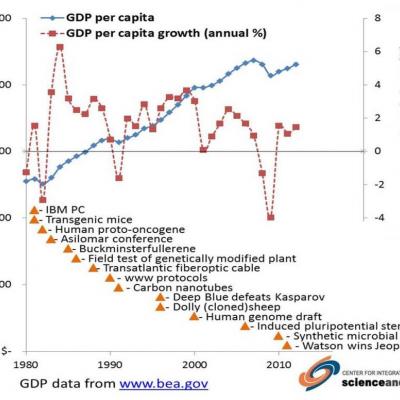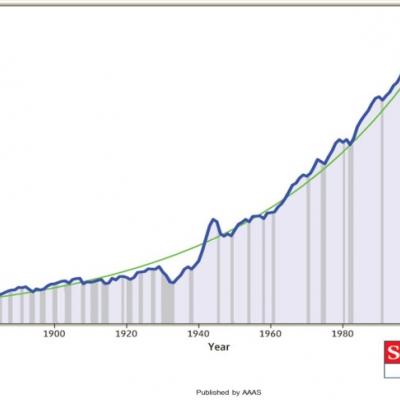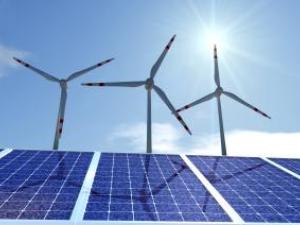Public support for science is related less to the wonder of scientific discovery than the expectation that scientific and technological advances will lead to new product, jobs, and economic growth. Recent evidence suggests that these outcomes are not certain. Fred Ledley argues that the public is often promised the benefits of scientific discoveries without adequate consideration of the business challenges inherent in translating science for public benefit.In his Presidential Address to the American Association for the Advancement of Science (AAAS), William Press asked “why society is willing to support an endeavor as abstract and altruistic as basic science research and an enterprise as large and practical as the research and development (R&D) enterprise as a whole.” His answer is that public support for science is related less to the wonder of scientific discovery, than the fact that “Discovery leads to technology and invention, which leads to new products, jobs, and industries.”This formulation of the value of science and technology has deep roots in the history of human civilization, which measures epochs of human cultural evolution by advances in metallurgy and energetics. It also has deep roots in the scientific enterprise itself, which has often been associated with advances in armament, agriculture, alchemy, and artisan trades. The contemporary formulation of the relationship between scientific discovery and the value it creates was formalized by two seminal works of the mid 20th century.The first was a report titled “Science The Endless Frontier” prepared by Vannevar Bush for President Franklin Roosevelt in 1945. That report made explicit the relationship between basic science and economic goals, stating: “One of our hopes is that after the war there will be full employment. To reach that goal the full creative and productive energies of the American people must be released. To create more jobs we must make new and better and cheaper products. We want plenty of new, vigorous enterprises. But new products and processes are not born full-grown. They are founded on new principles and new conceptions which in turn result from basic scientific research. Basic scientific research is scientific capital.” Bush’ implicit argument was that, since the frontiers of knowledge were endless, so too were the benefits that would accrue to the American public by supporting the scientific enterprise.The second was the work of economist Robert Solow who examined the contributions of economic capital and labor capital to an “aggregate production function.” Solow’s work recognized that economic and labor inputs could not account for the non-equilibrium condition of sustained economic growth. He postulated that the residuals in economic growth, that could not be accounted for by economic or labor capital, were due to technical change that increased the contribution, or productivity, or labor. Examining economic growth between 1909 and 1949, Solow concluded that economic growth had resulted from a doubling of worker productivity, with 87.5% of this increase attributable to “technical change” and the remaining 12.4% attributable to “increased use of capital.” In this formulation, “scientific capital,” which contributed to technical change, was formally recognized as a driver of economic growth. Press involves Solow’s work to argue that the long term exponential growth of the US GDP per capita since the late 19th century (Figure 1, from: WH Press, Science 2013;342:817-822) reflects the impact of technical change on the economy.Futurist Ray Kurzweil has argued that technology has advanced exponentially throughout the 20th century. He has shown, for example, that the speed of automated computation increased exponentially since 1900, progressing through “five paradigms ” of technologies, the most recent of which involves exponential advances in integrated circuits, often described as Moore’s Law. Kurzweil envisions a future of continuing, exponential change driven by advances in genetics/biotechnology, nanotechnologies, and robotics/artificial intelligence, collectively described as “GNR.” A seminal 2012 paper from the National Bureau of Economic Research titled “Is US Economic Growth over? Faltering innovations confronts the six headwinds” economist Robert Gordon presents a less optimistic view. Gordon’s analysis of recent economic trends suggests that technologies Kurzweil heralds have not produced the same economic growth as earlier innovations of the 19th and 20th century such as innovations in steam power, railroads, electricity, petroleum, or chemistry. While it is tempting to discount these observations as a temporary aberration association with the Great Recession, as Press does in his address to the AAAS, a careful analysis of GDP data since 1980 suggests a troubling trend.Figure 2 shows US GDP per capita, as well as the annual changes in US GDP per capita, from 1980-2012. While the GDP per capita has continued to grow over the past thirty years, episodic recessions notwithstanding, the rate of annual growth exhibits a long-term downward trend, suggesting that this growth has not been exponential (Data from: data.worldbank.org/indicator/NY.GDP.PCAP.KD).Recent decades have witnessed many extraordinary achievements in biotechnology, nanotechnology, computers, communications, and artificial intelligence, some of which are shown in figure 2. In fact, our research, and that of others, has demonstrated that many sectors of science and technology, ranging from computers and communications technologies, to biotechnology and nanotechnology, have experienced exponential progress throughout this period. If advances in science and technology constitute the dominant drivers of economic growth, as posited by Solow, then something is seriously amiss.Gordon ascribes the slowing of economic growth in recent decades to a number of demographic and economic “headwinds.” These include the ageing of the baby boom generation, the higher levels of education required to exploit new technologies, rising inequality, globalization, the constraints of energy and environmental resources, and patterns of borrowing and savings. In the face of these headwinds, Gordon writes that “…innovation does not have the same potential to create growth in the future as in the past…”The classical path by which scientific and technological innovations create economic growth involves two distinct enterprises; a scientific enterprise focused on the basic research, and a commercial enterprise that is responsible for the translation of these advances into products, services, jobs, and economic value. Bush noted in The Endless Frontier: “Basic research leads to new knowledge. It provides scientific capital. It creates the fund from which the practical applications of knowledge must be drawn.” The differentiated roles of the scientific enterprise and the commercial enterprise were further codified by the Bayh-Dole Act of 1980 , which normalized the transfer of this scientific capital from the scientific enterprise to commercial enterprises with business models that combine this scientific capital with the labor and economic capital required to develop successful products and services. In this context, the demographic and economic headwinds Gordon identifies are not categorical impediments to value creation from scientific and technological innovation, they are simply elements of the business environment faced by commercial enterprises involved in translational science. The fact that recent economic growth has lagged, even as science and technology have continued to advance exponentially, suggests that the prevailing business models for translational science are not working in the current business environment. A similar conclusion can be drawn from the limited progress that has been made in improving health outcomes for many common diseases, healthcare productivity, alternative energy production, sustainable resource utilization, food security, water management, transportation, and education in the face of exponential scientific and technological advances in these sectors.Gordon’s observations cannot be regarded as a temporary aberration; nor should they be a cause for undue pessimism. Rather, they should be seen as a clarion call for new, innovative business models that are attuned not only to the extraordinary potentials of emerging science and technology, but also to current and future business environments and the headwinds they will face.Press concluded his Presidential Address thus: “Our message is that science is a single, unified, long-term enterprise in which basic science discoveries, and research accomplishments of applied science and engineering, are things to be admired in their own right that also, often unpredictably, lead to better jobs and better lives, new products and new industries.” It is critical to recognize that the unpredictability of translational science arises as much from the complexity of business and the business environment, as from the complexity of science and its applications. Too often, the public is promised the benefits of scientific discoveries without adequate consideration of the business challenges inherent in translational science. Innovations that better integrate science and business in a long-term enterprise may improve the predictability and productivity of translational science and ensure that the public receives the return expected from society’s support for basic science.Fred Ledley is Director of the Center for the Integration of Science and Industry at Bentley University and also Professor of Natural & Applied Science and Management. Sources:Press, William H. "What's So Special About Science (And How Much Should We Spend on It?)." Science 342.6160 (2013): 817-822.www.nsf.gov/od/lpa/nsf50/vbush1945.htmSolow, Robert M. "Technical change and the aggregate production function." The review of Economics and Statistics 39.3 (1957): 312-320.Kurzweil, Ray. The singularity is near: When humans transcend biology. Penguin. com, 2005. www.singularity.comhttp://www.singularity.com/charts/page67.htmlGordon, Robert J. Is US economic growth over? Faltering innovation confronts the six headwinds. No. w18315. National Bureau of Economic Research, 2012. http://www.nber.org/papers/w18315http://www.gpo.gov/fdsys/pkg/USCODE-2011-title35/pdf/USCODE-2011-title35...







